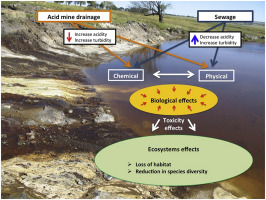当前位置:
X-MOL 学术
›
Chemosphere
›
论文详情
Our official English website, www.x-mol.net, welcomes your
feedback! (Note: you will need to create a separate account there.)
River catchment responses to anthropogenic acidification in relationship with sewage effluent: An ecotoxicology screening application
Chemosphere ( IF 8.1 ) Pub Date : 2017-09-18 , DOI: 10.1016/j.chemosphere.2017.09.084 P.J. Oberholster , A.-M. Botha , L. Hill , W.F. Strydom
Chemosphere ( IF 8.1 ) Pub Date : 2017-09-18 , DOI: 10.1016/j.chemosphere.2017.09.084 P.J. Oberholster , A.-M. Botha , L. Hill , W.F. Strydom

|
Rising environmental pressures on water resources and resource quality associated with urbanisation, industrialisation, mining and agriculture are a global concern. In the current study the upper Olifants River catchment as case study was used, to show that acid mine drainage (AMD) and acid precipitation were the two most important drivers of possible acidification during a four-year study period. Over the study period 59% of the precipitation sampled was classified as acidic with a pH value below 5.6. Traces of acidification in the river system using aquatic organisms at different trophic levels were only evident in areas of AMD point sources. Data gathered from the ecotoxicology screening tools, revealed that discharge of untreated and partially treated domestic sewage from municipal sewage treatment works and informal housing partially mitigate any traces of acidification by AMD and acid precipitation in the main stem of the upper Olifants River. The outcome of the study using phytoplankton and macroinvertebrates as indicator organisms revealed that the high loads of sewage effluent might have played a major role in the neutralization of acidic surface water conditions caused by AMD and acid precipitation. Although previous multi–stage and microcosm studies confirmed the decrease in acidity and metals concentrations by municipal wastewater, the current study is the first to provide supportive evidence of this co-attenuation on catchment scale. These findings are important for integrated water resource management on catchment level, especially in river systems with a complex mixture of pollutants.
中文翻译:

河流集水区对人为酸化的影响与污水排放的关系:生态毒理学筛选应用
与城市化,工业化,采矿和农业相关的对水资源和资源质量的环境压力的上升是全球关注的问题。在当前的研究中,以奥利凡茨河上游流域为例进行研究,结果表明,在为期四年的研究期内,酸性矿山排水(AMD)和酸性降水是可能酸化的两个最重要的驱动因素。在研究期间,采样的59%的降水被归类为酸性,pH值低于5.6。使用不同营养水平的水生生物在河流系统中产生的酸化痕迹仅在AMD点源区域才明显。从生态毒理学筛查工具收集的数据,透露,从市政污水处理厂和非正式房屋中排放未经处理和部分处理的生活污水,可以部分缓解AMD酸化的任何痕迹以及上奥利凡茨河主干道的酸沉降。使用浮游植物和大型无脊椎动物作为指示生物的研究结果表明,污水的高负荷可能在中和由AMD和酸沉淀引起的酸性地表水条件中起了主要作用。尽管先前的多阶段和微观研究证实了市政废水中酸度和金属浓度的降低,但当前的研究首次为流域规模上的这种共衰减提供了支持性证据。这些发现对于集水区一级的水资源综合管理非常重要,
更新日期:2017-09-19
中文翻译:

河流集水区对人为酸化的影响与污水排放的关系:生态毒理学筛选应用
与城市化,工业化,采矿和农业相关的对水资源和资源质量的环境压力的上升是全球关注的问题。在当前的研究中,以奥利凡茨河上游流域为例进行研究,结果表明,在为期四年的研究期内,酸性矿山排水(AMD)和酸性降水是可能酸化的两个最重要的驱动因素。在研究期间,采样的59%的降水被归类为酸性,pH值低于5.6。使用不同营养水平的水生生物在河流系统中产生的酸化痕迹仅在AMD点源区域才明显。从生态毒理学筛查工具收集的数据,透露,从市政污水处理厂和非正式房屋中排放未经处理和部分处理的生活污水,可以部分缓解AMD酸化的任何痕迹以及上奥利凡茨河主干道的酸沉降。使用浮游植物和大型无脊椎动物作为指示生物的研究结果表明,污水的高负荷可能在中和由AMD和酸沉淀引起的酸性地表水条件中起了主要作用。尽管先前的多阶段和微观研究证实了市政废水中酸度和金属浓度的降低,但当前的研究首次为流域规模上的这种共衰减提供了支持性证据。这些发现对于集水区一级的水资源综合管理非常重要,











































 京公网安备 11010802027423号
京公网安备 11010802027423号